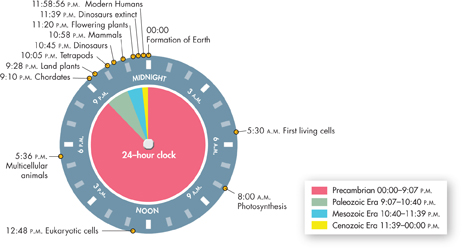VISUAL ANALOGY
GEOLOGIC TIME AS A CLOCK

FIGURE 19–6 It can be hard to think in terms of billions or even millions of years. To help visualize the enormous span of time since Earth formed, look at the 24-hour clock here. It compresses the history of Earth into a 24-hour period. Notice the relative length of Precambrian Time—almost 22 hours. Use Analogies Using this model, about what time did life appear? The first plants? The first humans?
ddDivisions of the Geologic Time Scale Divisions of geologic time have different lengths. The Cambrian Period, for example, began 542 million years ago and continued until 488 million years ago, which makes it 54 million years long. The Cretaceous Period was 80 million years long.
Geologists now recognize four eons. The Hadean Eon, during which the first rocks formed, spans the time from Earth's formation to about 4 billion years ago. The Archean Eon, during which life first appeared, followed the Hadean. The Proterozoic Eon began 2.5 billion years ago and lasted until 542 million years ago. The Phanerozoic (fan ur uh ZOH ic) Eon began at the end of the Proterozoic and continues to the present.
Eons are divided into eras. The Phanerozoic Eon, for example, is divided into the Paleozoic, Mesozoic, and Cenozoic Eras. And eras are subdivided into periods, which range in length from nearly 100 million years to just under 2 million years. The Paleozoic Era, for example, is divided into six periods, including the Permian Period.
MYSTERY CLUE

Paleontologists discovered dramatic changes in the fossil record at the end of the Permian Period. What methods do you think they used to date that change at 251 million years ago?
Naming the Divisions Divisions of the geologic time scale were named in different ways. The Cambrian Period, for example, was named after Cambria—an old name for Wales, where rocks from that time were first identified. The Carboniferous (“carbon-bearing”) Period is named for large coal deposits that formed during that time.
Geologists started to name divisions of the time scale before any rocks older than the Cambrian Period had been identified. For this reason, all of geologic time before the Cambrian was simply called Precambrian Time. Precambrian Time, however, actually covers about 90 percent of Earth's history, as shown in Figure 19–6.

Table of Contents
- Formulas and Equations
- Applying Formulas and Equations
- Mean, Median, and Mode
- Estimation
- Using Measurements in Calculations
- Effects of Measurement Errors
- Accuracy
- Precision
- Comparing Accuracy and Precision
- Significant Figures
- Calculating With Significant Figures
- Scientific Notation
- Calculating With Scientific Notation
- Dimensional Analysis
- Applying Dimensional Analysis




